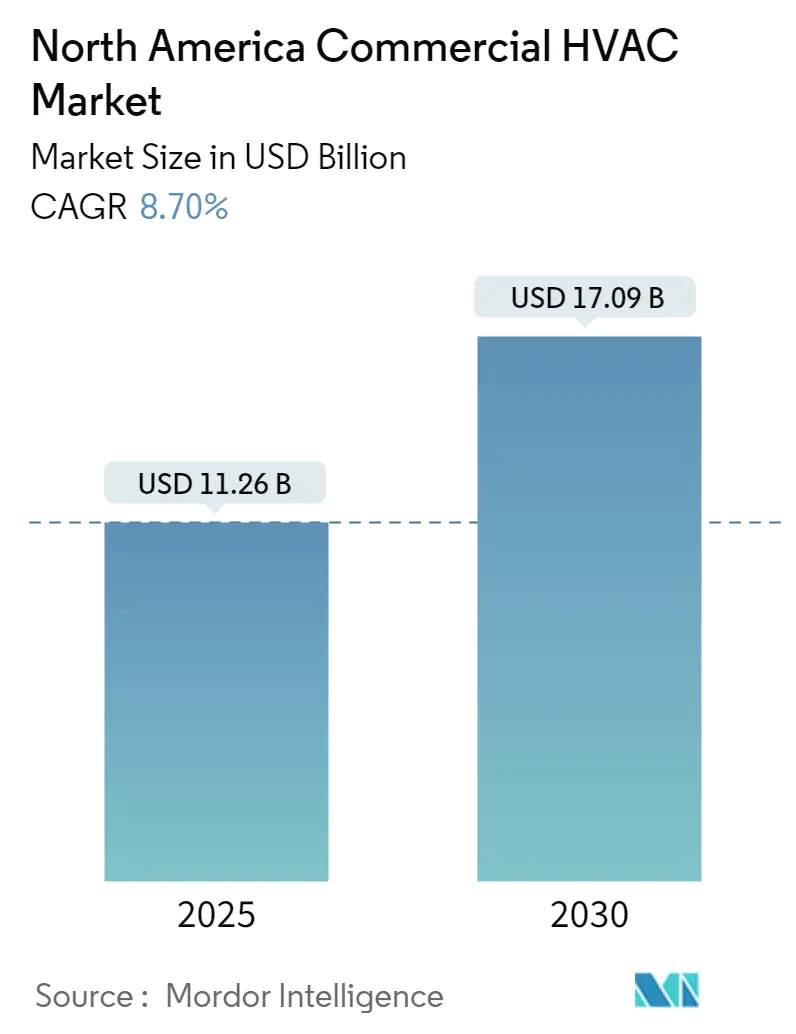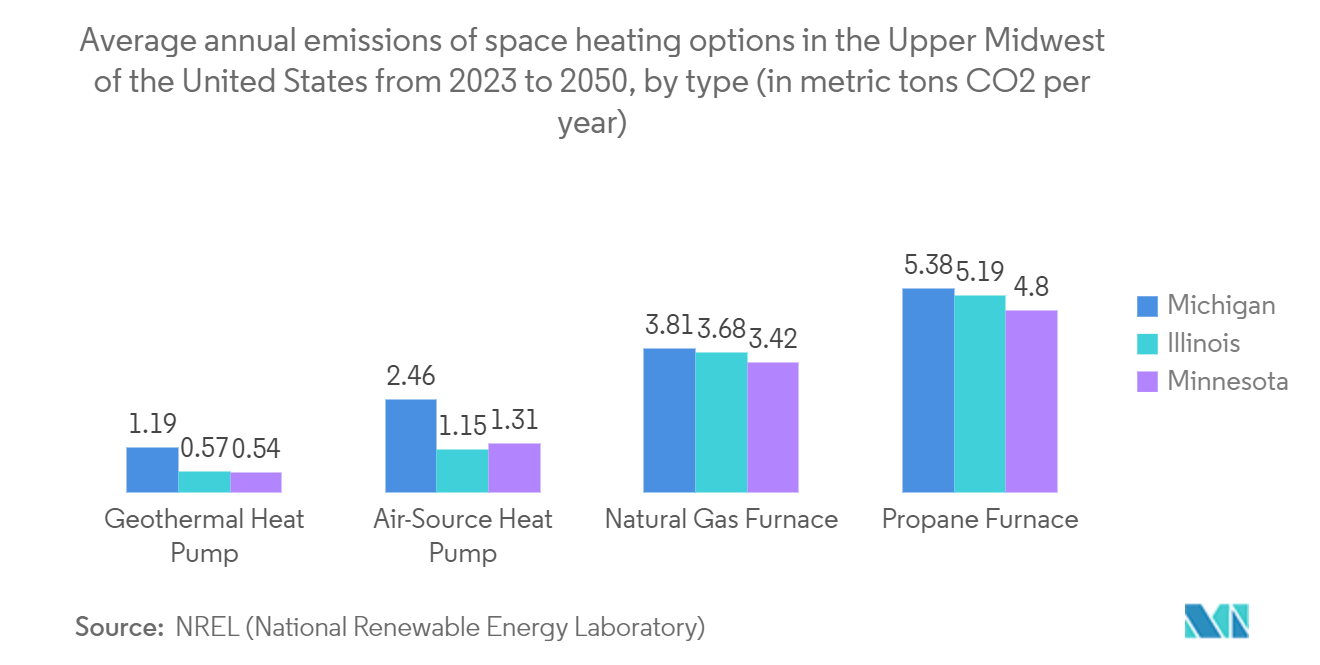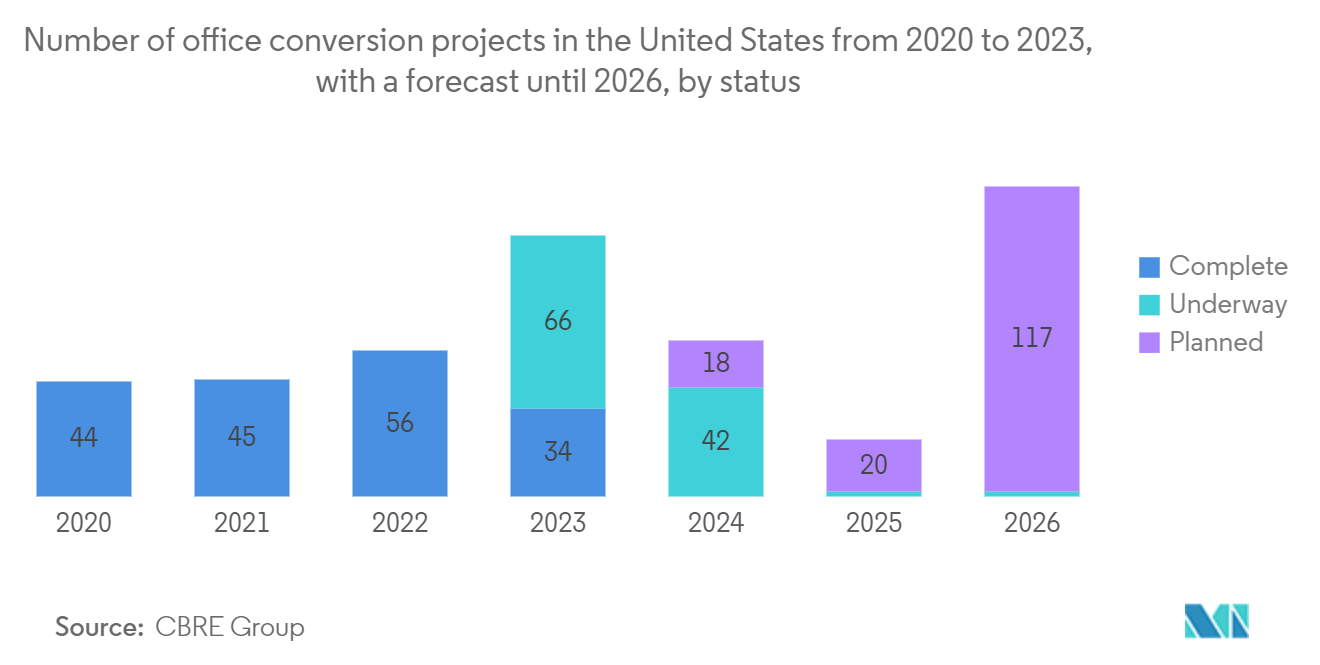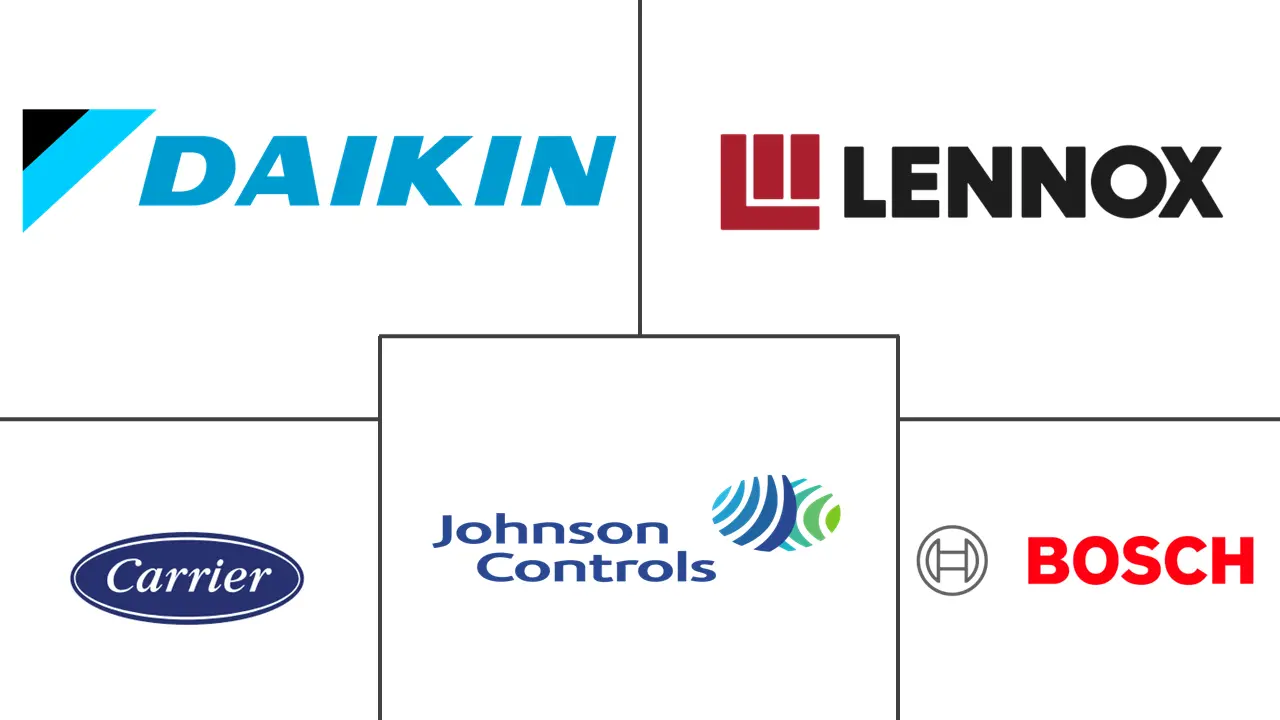North America Commercial HVAC Market Size and Share

North America Commercial HVAC Market Analysis by Mordor Intelligence
The North America Commercial HVAC Market size is estimated at USD 11.26 billion in 2025, and is expected to reach USD 17.09 billion by 2030, at a CAGR of 8.7% during the forecast period (2025-2030).
- Large volumes of greenhouse gas emissions are produced because a lot of buildings, including homes, workplaces, schools, and factories, still rely primarily on fossil fuels, mainly natural gas, for heating. Furthermore, the current energy crisis suggests that switching to more economical, dependable, and environment-friendly building heating methods is urgently needed. In this regard, one of the most important technologies to make heating more sustainable and safe is heat pumps, which can effectively heat buildings and, thus, support market growth.
- Furthermore, the region's growing need for office space, harsh weather patterns, and rising office building activity are some of the other factors propelling the market's growth. Another important factor propelling the North American commercial HVAC industry is the growing need for energy-efficient systems. Growing environmental consciousness has led to a preference shift toward environment-friendly technology, which is driving this industry's expansion.
- The continuous initiative by the government to adopt the HVAC system is expected to fuel market growth. For instance, in November 2023, the Biden administration's initiative to enhance the adoption of electric heat pumps and decrease the dependency on fossil fuels involves a substantial investment of USD 169 million by the US Department of Energy. This funding will be utilized to facilitate the expansion of manufacturing facilities for heat pumps, as well as the production of crucial components like compressors and refrigerants. Such increasing investments by government agencies are expected to drive the demand for heat pumps.
- Furthermore, in November 2023, the government of Canada announced an investment of CAD 384 million (USD 280.65 million) to support retrofits to the Carnegie Building in Saint John. This investment will contribute to improving the heating, ventilation, and air conditioning system in the Carnegie Building and implementing the highest efficiency LED lighting, which is estimated to result in significant energy savings for the cultural heritage of the town. This improvement is expected to reduce the facility's energy consumption by an estimated 56.9% and greenhouse gas emissions by 43.8 tonnes per year.
- Some of the advances in heating, ventilation, and air conditioning systems have become known to most commercial property owners and managers. The latest technologies are taken into account when new buildings are being built or planned.
- The increasing energy prices worldwide make energy-efficient HVAC systems attractive for cost savings. Despite the potential benefits, the initial expenses of installing these systems could limit their widespread use and hinder market expansion.
- The prolonged conflict between Russia and Ukraine is also anticipated to have a big effect on the electronics sector. The conflict may result in additional disruptions and impact semiconductor supply chains, driving up the cost of electronics even further. It is anticipated that the conflict will have a substantial overall effect on the electronics sector. This would make it more difficult to produce HVAC equipment.
North America Commercial HVAC Market Trends and Insights
Increasing Demand for Heating Equipment in Commercial Buildings Will Drive Market Growth
- The use of heat pumps as the primary energy source for commercial buildings is growing as they are used to provide hot water, space heating, and cooling in various commercial buildings, including office buildings, hotels, hospitals, and schools.
- The growing demand for space heating on business premises is an important factor driving market growth. Moreover, increasing demand for commercial boilers is being driven by the acceptance of energy efficiency solutions and significant investments to build environmentally conscious buildings that reduce CO2 emissions.
- Cleantechnica reports that, currently, 4.7 million heat pumps are installed in the United States. To meet the increasing demand and fulfill the targets set by the state alliance, numerous companies are continuously investing in the region to enhance the production of heat pumps. For instance, in November 2023, Johnson Controls received a grant of USD 33 million from the US Department of Energy's Office of Manufacturing and Energy Supply Chains. This grant aims to support the expansion of three manufacturing sites in the United States to boost domestic production of electric heat pumps.
- With these facilities working together, they will have the capacity to manufacture around 200,000 electric heat pumps annually, resulting in a significant production increase of nearly 200%. This grant is a part of the Biden Administration's utilization of the Defense Production Act to enhance domestic production of five crucial clean energy technologies, including heat pumps.
- Several companies are constantly investing in introducing various products catering to the demand for these heating systems in the commercial segment. For instance, in March 2024, LG Electronics Canada announced the introduction of its latest heat-pump-enabled HVAC solution, the LG R32 Air-to-Water Heat Pump Monobloc system. It offers seamless installation in which hydronic components and water pipes are incorporated to eliminate the need for refrigeration piping.
- Furthermore, according to NREL (National Renewable Energy Laboratory), between 2023 and 2050, heat pumps are expected to generate significantly fewer CO2 emissions in the Upper Midwest of the United States than other heating options. Nevertheless, geothermal heat pumps were slightly more climate-friendly than the air-source type. While geothermal heat pumps were expected to generate, on average, 0.57 metric tons of CO2 every year, a propane furnace would generate 5.19 metric tons of CO2 annually.

The United States is Expected to Hold Significant Market Share
- The demand for commercial HVAC in the United States is increasing due to climate variations, extreme weather, energy efficiency initiatives, and government regulations to reduce carbon emissions. For instance, in April 2024, the US Department of Energy launched a program to turbocharge the manufacture and deployment of next-generation heat pumps for commercial buildings. The accelerator is a public-private partnership that brings together manufacturers, owners of commercial buildings, and the DOE national labs. Its goal is to accelerate the development of more affordable and efficient packaged rooftop units, or cold-climate heat pumps, that are installed on flat commercial roofs.
- Similarly, in September 2023, a significant initiative was launched by a group of 25 state governors with the goal of deploying 20 million heat pumps by 2030. This represented a quadrupling of the number of heat pumps installed in 2020. Bipartisan governors who together represent 60% of the US economy and 55% of the country's population have committed to installing 20 million heat pumps by 2030 and collectively call themselves the US Climate Alliance.
- Moreover, the use of energy-efficient air conditioning equipment in commercial buildings is influenced by energy standards and regulations, such as those established by Energy Star and the US Department of Energy (DoE). To lower operating costs and their environmental impact, building owners and operators prioritize equipment with high seasonal energy efficiency ratios (SEER) and energy-saving features.
- Furthermore, the expansion of office buildings in the country will support the market growth. According to CBRE Group, between 2018 and 2023, the number of office conversion projects in the United States grew steadily. The year 2023 witnessed the most significant increase, with the number of office conversion projects nearly doubling from the previous year.

Competitive Landscape
The North American commercial HVAC market is fragmented, favorably competitive, and has several prominent players. The market performers are focusing on expanding their consumer base across the region by leveraging strategic collaborative initiatives to increase their market share and profitability. These enterprises leverage strategic collaborative initiatives to boost their market share and profitability. Carrier Corporation, Daikin Industries Ltd, Robert Bosch GmbH, Lennox International Inc., and Johnson Controls International PLC are among the major players in the market.
- May 2024: The Stelpro and Innovair Solutions groups announced a strategic partnership to stimulate growth and transform the future of the HVAC market. This collaboration marked a major milestone for entities, strengthening their position in the North American market and propelling their future growth. Both companies will offer a diversified range of thermal comfort and indoor air quality solutions to meet the needs of the commercial, residential, industrial, and institutional markets under 15 renowned brands.
- May 2024: Daikin Industries announced a strategic partnership with its subsidiary Alliance Air Products to expand its manufacturing capabilities to support sustainable data center growth across North America.
North America Commercial HVAC Industry Leaders
Daikin Industries, Ltd.
Carrier Corporation
Lennox International Inc.
Johnson Controls International Plc
Robert Bosch GmbH
- *Disclaimer: Major Players sorted in no particular order

Recent Industry Developments
- May 2024: Lennox International announced the launch of a new HVAC line that reduces global warming potential ‘by up to 78%’. The new Lennox heating, ventilation, and air conditioning products will offer a comprehensive range of products and will use the environmentally responsible refrigerant R454B, which reduces global warming potential by as much as 78%.
- April 2024: XNRGY, a North American player providing sustainable HVAC solutions, announced the groundbreaking of its new manufacturing facility in Mesa, Arizona. This groundbreaking ceremony marks the beginning of a four-phase development plan, which will ultimately create an enormous 1 million sq. ft sustainability manufacturing hub in the area.
North America Commercial HVAC Market Report Scope
The study tracks the revenue accrued through the sale of commercial HVAC equipment and services by various players in the North American market. The study also tracks the key market parameters, underlying growth influencers, and major vendors operating in the industry, which supports the market estimations and growth rates over the forecast period. The report’s scope encompasses market sizing and forecasts for the various market segments.
The North American commercial HVAC market is segmented by type of component (HVAC equipment [heating equipment, air conditioning/ventilation equipment] and HVAC services), end-user (hospitality, commercial buildings, public building, and other end-user industries), and country (United States and Canada). The market sizes and forecasts are provided in terms of value (USD) for all the above segments.
| HVAC Equipment | Heating Equipment |
| Air Conditioning /Ventillation Equipment | |
| HVAC Services |
| Hospitality |
| Commercial Buildings |
| Public Buildings |
| Other End-user Industries |
| United States |
| Canada |
| By Type of Component | HVAC Equipment | Heating Equipment |
| Air Conditioning /Ventillation Equipment | ||
| HVAC Services | ||
| By End-user Industry | Hospitality | |
| Commercial Buildings | ||
| Public Buildings | ||
| Other End-user Industries | ||
| By Country | United States | |
| Canada |
Key Questions Answered in the Report
How big is the North America Commercial HVAC Market?
The North America Commercial HVAC Market size is expected to reach USD 11.26 billion in 2025 and grow at a CAGR of 8.70% to reach USD 17.09 billion by 2030.
What is the current North America Commercial HVAC Market size?
In 2025, the North America Commercial HVAC Market size is expected to reach USD 11.26 billion.
Who are the key players in North America Commercial HVAC Market?
Daikin Industries, Ltd., Carrier Corporation, Lennox International Inc., Johnson Controls International Plc and Robert Bosch GmbH are the major companies operating in the North America Commercial HVAC Market.
What years does this North America Commercial HVAC Market cover, and what was the market size in 2024?
In 2024, the North America Commercial HVAC Market size was estimated at USD 10.28 billion. The report covers the North America Commercial HVAC Market historical market size for years: 2024. The report also forecasts the North America Commercial HVAC Market size for years: 2025, 2026, 2027, 2028, 2029 and 2030.
Page last updated on:
North America Commercial HVAC Market Report
Statistics for the 2025 North America Commercial HVAC market share, size and revenue growth rate, created by Mordor Intelligence™ Industry Reports. North America Commercial HVAC analysis includes a market forecast outlook for 2025 to 2030 and historical overview. Get a sample of this industry analysis as a free report PDF download.



